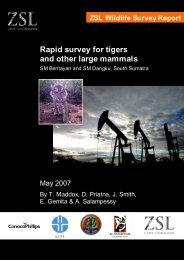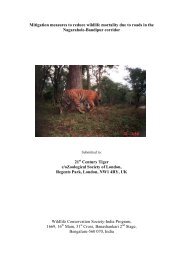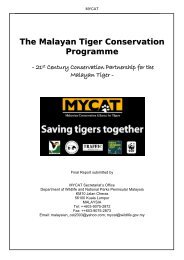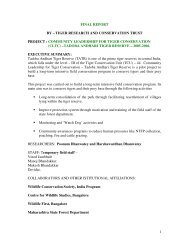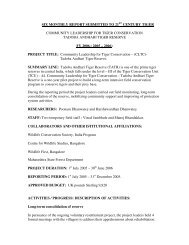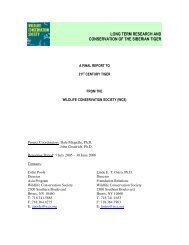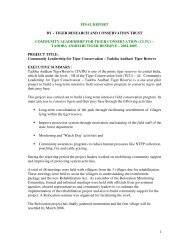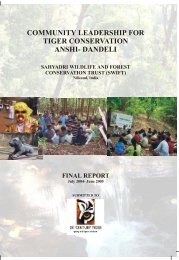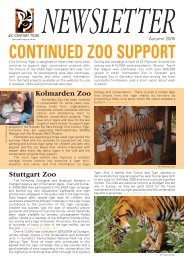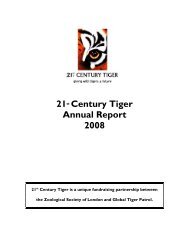The conservation of tigers and other wildlife in oil palm plantations
The conservation of tigers and other wildlife in oil palm plantations
The conservation of tigers and other wildlife in oil palm plantations
You also want an ePaper? Increase the reach of your titles
YUMPU automatically turns print PDFs into web optimized ePapers that Google loves.
importance <strong>of</strong> marg<strong>in</strong>al or degraded habitats <strong>of</strong>ten found with<strong>in</strong> <strong>palm</strong> <strong>oil</strong> concessions,<br />
which can reta<strong>in</strong> high <strong>conservation</strong> values. This has important implications for the<br />
<strong>palm</strong> <strong>oil</strong> <strong>in</strong>dustry, both <strong>in</strong> guid<strong>in</strong>g new plant<strong>in</strong>g <strong>and</strong> as a mechanism for reduc<strong>in</strong>g<br />
impacts on local <strong>wildlife</strong> populations. It also has serious implications for large-scale<br />
l<strong>and</strong>-use plann<strong>in</strong>g, both by governments <strong>and</strong> <strong>conservation</strong>ists, show<strong>in</strong>g that<br />
<strong>conservation</strong> value occurs widely outside primary forest <strong>and</strong> exist<strong>in</strong>g def<strong>in</strong>itions <strong>and</strong><br />
criteria must be broadened to reflect this. F<strong>in</strong>ally, the study concludes that the fragility<br />
<strong>of</strong> <strong>wildlife</strong> survival <strong>in</strong> unprotected areas is such that active management <strong>and</strong><br />
protection is essential if <strong>conservation</strong> value is to be anyth<strong>in</strong>g more than transient.<br />
<strong>The</strong> report ends with recommendations for action to mitigate the impacts <strong>of</strong> <strong>oil</strong> <strong>palm</strong><br />
on <strong>wildlife</strong> survival at three levels. First, it is recommended that current policies on<br />
avoid<strong>in</strong>g forest clearance for new plant<strong>in</strong>g are supplemented with field surveys <strong>in</strong><br />
degraded areas to identify which are low priority <strong>and</strong> which are <strong>in</strong> fact <strong>in</strong>tegral to<br />
<strong>wildlife</strong> <strong>conservation</strong> on a l<strong>and</strong>scape scale. Second, recommendations are made on<br />
how to best manage exist<strong>in</strong>g <strong>plantations</strong>, primarily through placement <strong>and</strong><br />
management <strong>of</strong> unplanted areas to reduce impacts on local <strong>wildlife</strong> populations. Third,<br />
biodiversity <strong>of</strong>fsets are suggested for <strong>oil</strong> <strong>palm</strong> <strong>plantations</strong>, as only with additional<br />
action <strong>of</strong>fsite can the entire impact <strong>of</strong> a plantation be mitigated. It is also recognised<br />
that such actions need to be taken as part <strong>of</strong> a wider, collaborative l<strong>and</strong>scape approach<br />
if significant <strong>and</strong> susta<strong>in</strong>able impacts are to be achieved. <strong>The</strong> f<strong>in</strong>al section therefore<br />
proposes a collaborative framework for <strong>conservation</strong> between protected areas on a<br />
l<strong>and</strong>scape scale, <strong>in</strong>to which action by the <strong>oil</strong> <strong>palm</strong> <strong>in</strong>dustry must be fitted.<br />
Conservation outside protected areas is essential if many <strong>wildlife</strong> populations <strong>and</strong><br />
endangered species are to survive <strong>in</strong>to the future. <strong>The</strong> <strong>palm</strong> <strong>oil</strong> <strong>in</strong>dustry represents<br />
one <strong>of</strong> the key l<strong>and</strong> users <strong>in</strong> these areas with one <strong>of</strong> the largest environmental<br />
‘footpr<strong>in</strong>ts’. If <strong>palm</strong> <strong>oil</strong> production is carried out without regard for environmental<br />
impacts it is also likely to be a key factor <strong>in</strong> the ext<strong>in</strong>ction <strong>of</strong> a range <strong>of</strong> tropical species.<br />
But if production is developed responsibly, with environmental impacts mitigated as<br />
far as possible, <strong>oil</strong> <strong>palm</strong> should be able to provide important economic growth <strong>and</strong><br />
development <strong>in</strong> the region without turn<strong>in</strong>g some <strong>of</strong> the earth’s most important tropical<br />
ecosystems <strong>in</strong>to ecological deserts. This is a big “if”, <strong>and</strong> achiev<strong>in</strong>g responsible<br />
development is a major challenge; but it is one that must be met if biodiversity <strong>and</strong><br />
ecosystem functionality are to be conserved <strong>in</strong> Indonesia <strong>and</strong> elsewhere.<br />
2 Wildlife <strong>conservation</strong> <strong>in</strong> <strong>oil</strong> <strong>palm</strong> <strong>plantations</strong>




